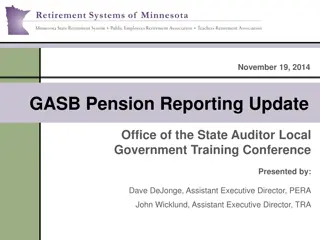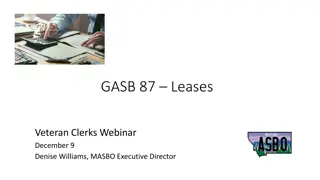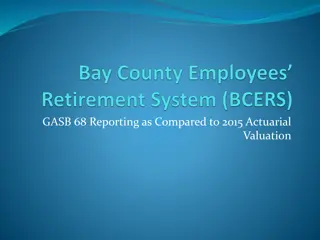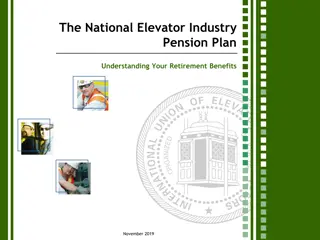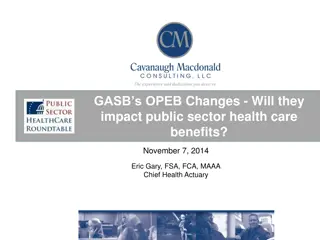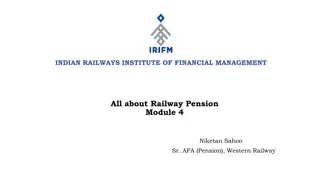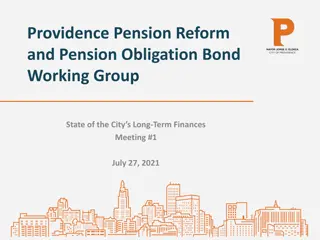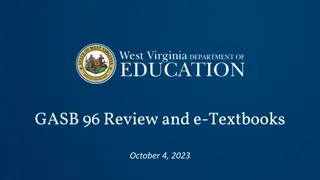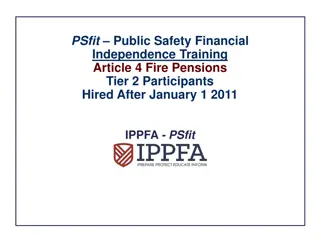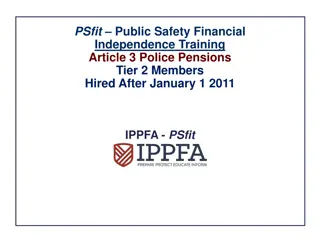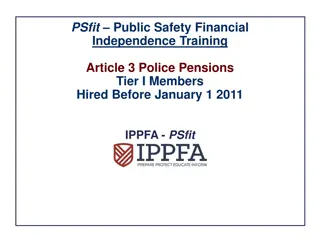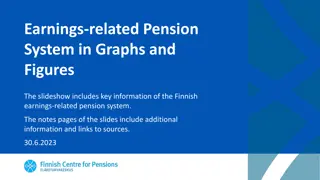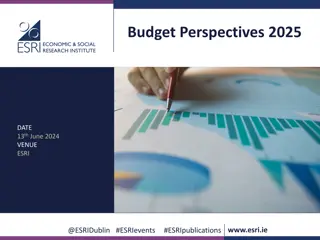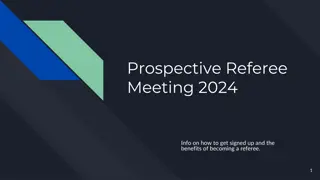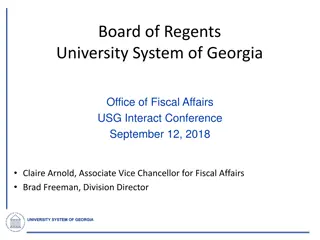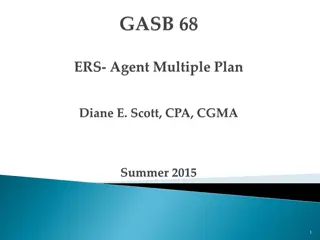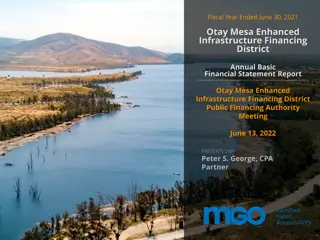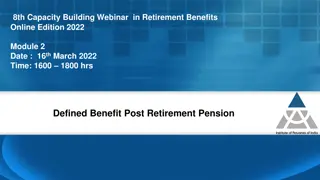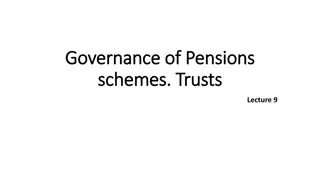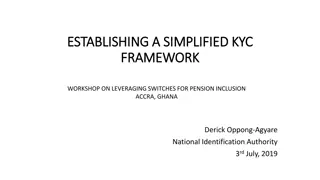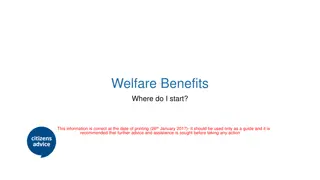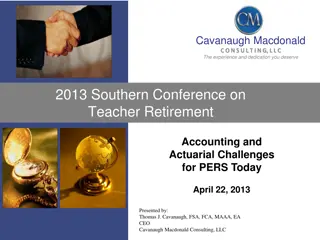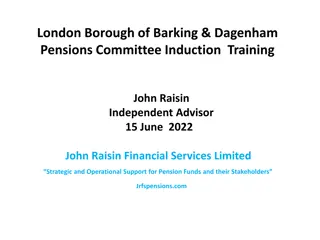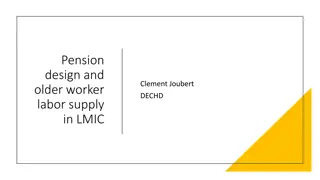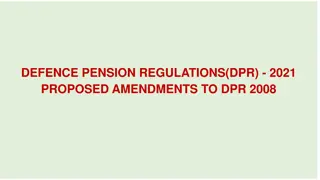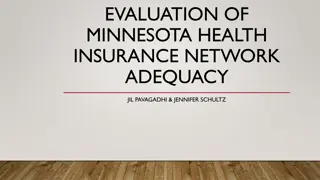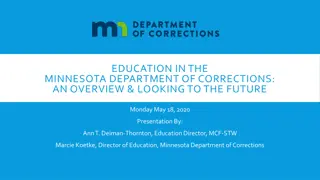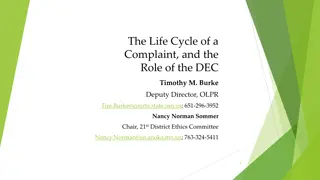GASB Pension Reporting Update for Minnesota - November 14, 2014
GASB updates impacting PERA and TRA pension reporting in Minnesota, including GASB 67 and 68 changes, implications for school districts and employer units, and major reporting changes affecting net pension liability.
Download Presentation

Please find below an Image/Link to download the presentation.
The content on the website is provided AS IS for your information and personal use only. It may not be sold, licensed, or shared on other websites without obtaining consent from the author. Download presentation by click this link. If you encounter any issues during the download, it is possible that the publisher has removed the file from their server.
E N D
Presentation Transcript
November 14, 2014 GASB Pension Reporting Update Minnesota Association of School Business Officials (MASBO) Presented by: Dave DeJonge, Assistant Executive Director, PERA John Wicklund, Assistant Executive Director, TRA
On the doorstep of implementation GASB 67: Pension Plan Reporting PERA and TRA will implement for their CAFRs for the period ending June 30, 2014. GASB 68: Accounting and Financial Reporting for Pensions School districts will implement for CAFRs for the period ending June 30, 2015. 2
GASB Statement 67 (Effective for FY 2014 PERA and TRA CAFRs released December 2014) Replaces current Statement of Plan Net Assets with Statement of Fiduciary Net Position (GASB 63). Replaces current Statement of Changes in Plan Net Assets with Statement of Changes in Fiduciary Net Position (GASB 63). Revisions to Notes to the Financial Statements. Required Supplementary Information (RSI): Ten-year Funding Trends. Required Supplementary Information (RSI) Schedule of the Net Pension Liability. Conclusion: Little impact on employer units. 3
GASB Statement 68 impact on employer units (FY2015) Government-wide financial statements, not fund-level statements. PERA/TRA perform with actuarial valuation reports every 6/30/xx. Results done 12/1/xx. PERA/TRA calculate proportionate share assigned to each employer unit (based on employer contributions). PERA/TRA transmits assets, liabilities, disclosure data, Required Supplementary Information to each employer. Large unfunded actuarial liabilities exist (now called Net Pension Liability). Result: Many employers will experience sticker shock at their share of the net pension liability, higher than net assets reported. (Remember: Liabilities paid over decades.) 4
Major reporting changes: Statement of net position (GASB 68) Adds net pension liability (NPL) similar to the unfunded liability PERA and TRA report today (government-wide financial statements). Pension expense for school district is the difference between beginning NPL and ending NPL. Deferred inflows and deferred outflows retained from GASB 63 and 65. Affects timing of expenses. Example: Investment gains or losses smoothed over five years. 5
Required supplementary information Schedule of the Net Pension Liability: Ten year schedule presenting: Employer s percentage and amount of NPL Employer s covered employee payroll Employer s NPL as percentage of covered employee payroll Pension plan s Fiduciary Net Position (FNP) as a percentage of TPL 6
Required supplementary information Schedule of Employer Contributions Ten-year schedule presenting: Statutorily required employer contribution Actual contributions paid by employer Difference between required contributions and paid contributions Amount of contributions paid in relation to required contributions as a percentage of the employer s covered- employee payroll 8
Required supplementary information Schedule of Employer Contributions 9
Notes to the financial statements Adds more extensive note disclosures, including sensitivity analysis of investment return assumption Requires employer to track annual balances of deferred outflows of resources and inflows of resources. Must describe significant assumptions and other inputs used to measure total pension liability. PERA/TRA to provide suggested footnotes 10
GASB 67-68 timeline: Measurement dates for school districts Release of 7/1/14 actuarial valuation results School districts use 7/1/14 actuarial valuation results Actuarial valuation measurement date School district CAFRs w/GASB 68 published Retirement systems transmit results to school districts Measurement period July 1, 2013 June 30, 2015 Late 2015 June 30, 2014 Dec. 1, 2014 Key point: There will be a one-year lag in school district reporting of GASB 68 results. Example: School districts, in their FY 2015 reporting, will use FY 2014 actuarial valuation results from PERA and TRA. 11
GASB 68 implementation guide Released January 2014. www.gasb.org 272 Q&A (questions 121-217): Cost-sharing employers. Appendix 3 (PERA and TRA are multi-employer cost- sharing plans). Illustration 3a, 3b are helpful. 12
PERA TRA plan level Perform annual actuarial valuations to determine funded status and liabilities Require plan actuary to calculate collective amount of items requiring deferred treatment Engage external auditor (unknown at present) to audit actuarial census data and schedule of employer s proportionate share Communicate results to the school districts Provide RSI and suggested footnotes 13
Determination of employer proportionate share Allocation based on employer contributions for fiscal year Time lag schools will use FY14 results and data for their FY15 CAFR PERA/TRA to provide GASB 68 allocations to each employer based on plan totals calculated by actuary Allocation policy is in progress 14
Determination of employer proportionate share--PERA Allocation based on employer contributions for fiscal year, but not all contributions reflect future contribution effort, so some will be excluded from the allocation. 15
GASB Statement No. 68 (Paragraphs 48-51) Statement of net position for FY ended June 30, 2015: Cost-sharing employers Total Assets Liabilities Accounts payable Salaries payable Total pension liability Total Liabilities Change from old GASB $x,xxx,xxx $xx,xxx $xx,xxx $x,xxx,xxx (New) $x,xxx,xxx Net Position Possibly negative Remember: Pension liability is paid over decades of time and could be very volatile based on conditions of the pension fund at the state level. 16
GASB 71 Amends paragraph 137 of Statement 68 Contributions after the measurement date prior to fiscal year end Booked to deferred outflows rather than pension expense (GASB 63) At the beginning of the period in which the provisions of Statement 68 are adopted the government should recognize a beginning deferred outflow of resources only for its pension contributions (with an offset to Net Position). 17
GASB 71 Measurement Period Prior Employer s Fiscal Year End Begin New Measurement Date Measurement Date Def Outflows June 30, 2013 June 30, 2014 June 30, 2015 18
Determination of employer proportionate share Schedule of employer allocations (6/30/20X5) Employer Actual Employer Contributions Employer Allocation Percentage Employer 1 $2,143,842 36.376 Employer 2 268,425 4.554 Employer 3 322,142 5.466 Employer 4 483,255 8.199 Employer 5 633,125 10.742 Employer 6 144,288 2.448 Employer 7 95,365 1.618 Employer 8 94,238 1.599 Employer 9 795,365 13.495 Employer 10 267,468 4.538 Employer 11 403,527 6.847 Employer 12 165,886 2.815 Employer 13 68,454 1.161 Employer 14 6,240 0.106 Employer 15 2,144 0.036 19 Total $5,893,764 100.000
Example A: Net pension liability (employer 2) Employer proportionate share 4.554% TRA net pension liability (estimated) $4 billion Employer 2 initial liability on July 1, 2014 $182,160,000 20
Pension expense NPL Components immediately recognized in PE: Item Effect on PE Service Cost (Normal Cost) Increase Interest on the TPL Increase Projected Investment Earnings Decrease Member Contributions Decrease Administrative Costs Increase Benefit Provision Changes Increase or Decrease 21
Pension expense Components deferred and recognized later include: Item Amortization Period Difference between actual and projected earnings on investments 5 Years Changes in actuarial assumptions (mortality, disability, salary growth, inflation, payroll growth, etc.) Closed period equal to the average of the expected remaining service lives of all employees (active, inactive, and retirees) Difference between actual and assumed actuarial experience Deferred portions are accumulated as deferred outflows of resources or deferred inflows of resources and recognized as PE in future years 22
Pension expense Item Pension Expense Deferred Outflows Deferred Inflows Service Cost Interest on TPL Projected Investment Earnings $20,000 $10,000 $ (8,000) Member Contributions Admin Expenses Change in Benefit Provisions Change in Assumptions (8 years) $ (1,000) $ 100 $ (200) $ 100 $ 1,000 $ 300 Diff. Between Assumed and Actual Experience (8 years) Diff. Between Actual & Projected Investment Earnings (5 Years) Total $ (50) $ 150 $ 500 $ (100) $ 400 23 $20,850 $ 1,150 $1,200
Pension expense 8-Year Allocation Actuary-Determined Impact Current Deferred Change in assumption Change in assumption Current year pension expense +1,142 loss $142 $1,000 (outflow loss) $300 (inflow gain) +342 gain ($42) _____ $100 Difference in assumed Actual experience +171 loss $21 $150 (outflow loss) $500 (inflow gain) +571 gain ($71) _____ ($50) Current year pension expense Investment experience +500 gain ($100) $400 (inflow gain) 24
TRA Actuarial Valuation Reports: December 2014 Two reports 1. Accounting valuation (GASB 67-68) TRA Annual Financial Report for financial reporting, not funding determinations. 2. Funding Valuation Report Prepared with statutory assumptions and requirements determined by Minnesota Legislature. Two reports different assumptions and methodologies. 25
GASB 67-68 Actuarial Valuation Results TRA s actuary will deliver the collective: Net Pension Liability Deferred outflows of resources by category Deferred inflows of resources by category Results allocated and shared among 590 employer units Pension expense TRA 26
Determination of employer proportionate share Allocation based on employer contributions for fiscal year Each employer unit (school district) will have a percentage of TRA s results The percentage will be recalculated every year TRA has a special funding situation impacting the calculation 27
Special funding situation GASB 68 requires allocation of TRA net pension liability and other financial results to employer units. Allocation based on annual employer contributions. Based on the Minneapolis and Duluth teacher mergers, TRA receives $16 million/year for Minneapolis and $14 million for Duluth. Question: How do direct state aid payments impact the allocation of TRA results? GASB 68 paragraph 15 defines a special funding situation. After a conference call with GASB and MMB, TRA will treat the State of Minnesota as an employer unit in the allocation of pension liability and expense. 28
Audit issues TRA Audited financial statements of the plan only include disclosure of the collective net pension liability for the TRA plan as a whole. Does not include specific employer detail for: o Deferred outflows/inflows of resources by category o Pension expense o Each participating employer s share of collective pension amounts Problem: Audited financial statements of the plan may not include necessary information to calculate allocation percentages. Lack of audit evidence for external auditor. 29
Audit solution TRA prepares Schedule of Employer Allocations, for which plan auditor is engaged to provide opinion. Schedule includes the following elements for each employer: o Net Pension Liability o Deferred outflows of resources by category o Deferred inflows of resources by category o Pension expense For the GASB 68 allocation schedule TRA has engaged the Office of the State Auditor to verify the schedules distributed to the employer units. 30
Audit issues: Census data Auditing white paper guidance prescribes auditor must test member census data. Example census data includes date of birth, years of service, pay TRA is currently working with the Office of the State Auditor (OSA) on site visits to sample employer units. Sample will be a risk-based approach by OSA. Other risk factors may include: o Past errors or control deficiencies o New employer o Length of time since last audit o Media stories 31
TRA: Communication of GASB 68 results Financial statement Required supplementary information Notes to the financial statements Report anticipated to be released by TRA in spring 2015 o Attestation letter from the Office of the State Auditor Exact mode for communication of report yet to be determined 32
Key messages GASB 68 divorces funding and accounting (Your GASB 68 pension expense will not match what the employer actually contribute to the plan.) Unfunded pension liabilities exist today (GASB 68 changes who reports them) Unfunded pension liabilities may be very large to the employer (liabilities represent pension payments due over decades of time) Governing boards will still need to develop a funding policy to pay off the liabilities (No different than today) 33
Resources 34
PERA-TRA resources Visit the Employer tab on PERA s and TRA s websites. www.mnpera.org www.minnesotatra.org/employerinfo/gasb You ll find: Links to GASB publications. Links to AICPA audit guidance. Toolkit of informational guides/articles. Frequently asked questions. News and developments on implementation. Questions? E-mail Dave Dejonge (PERA) dave.dejonge@mnpera.org, or John Wicklund (TRA) jwicklund@minnesotatra.org. 35


